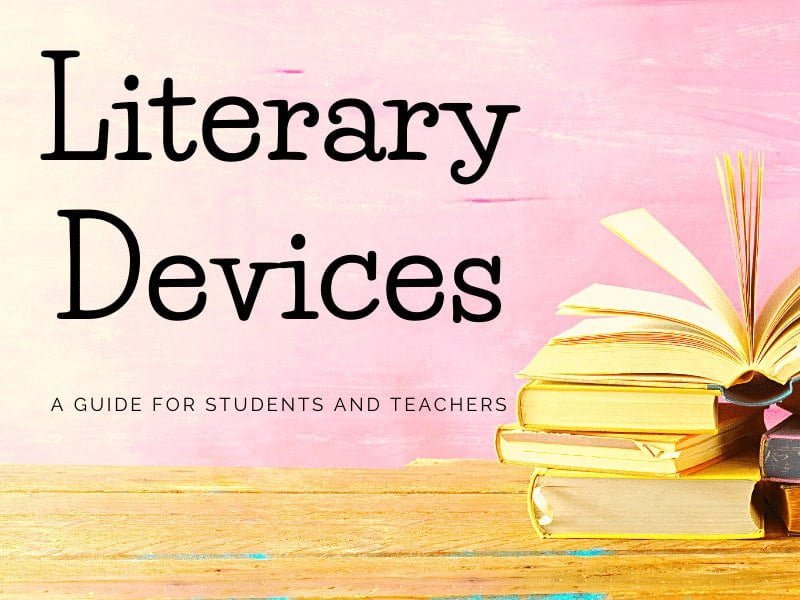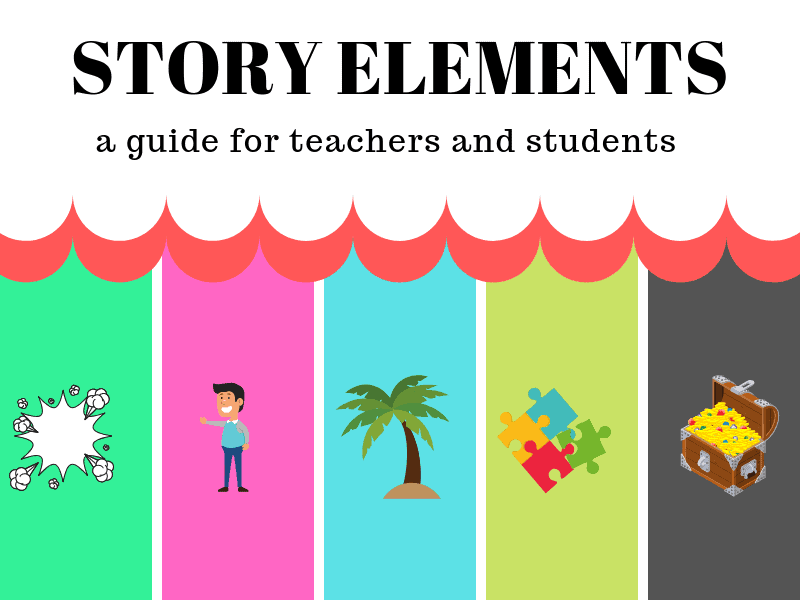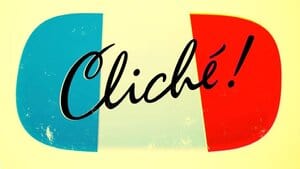A Complete guide to figurative language for students and teachers.
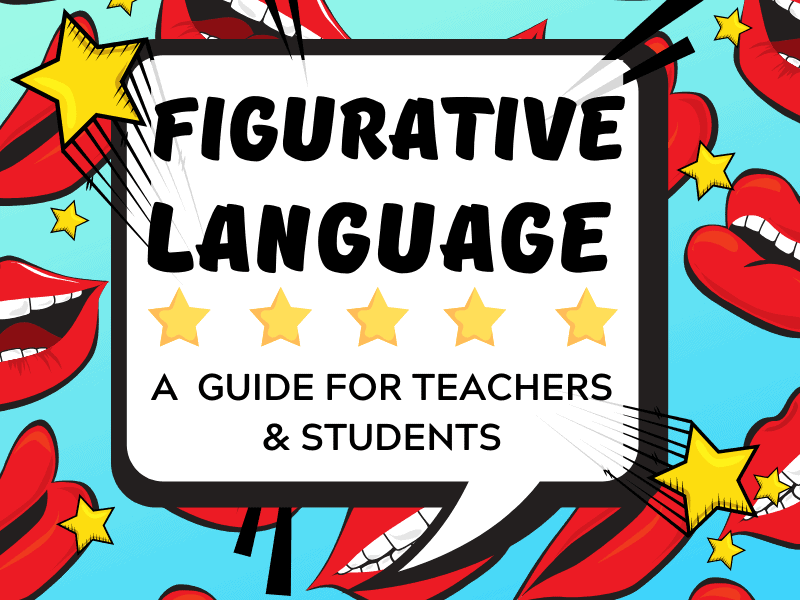
WHAT IS FIGURATIVE LANGUAGE? A DEFINITION

We most often associate figurative language with poetry, but we find figurative language widely used in many other contexts too. We find it in use in everything from fiction and folk music to drama and our daily speech.
The term figurative language refers to any use of language that goes beyond the literal meaning of the words themselves. In many instances, the phrase also refers to instances where the use of sounds, syntax, and word order deviates from what is considered the normal patterns of use. It is this definition that we will explore in this guide to uncover different figurative language types.
WHY DO WE USE FIGURATIVE LANGUAGE?
In both regards mentioned above, figurative language represents a sophisticated, creative use of language to convey meaning and mood, among other effects. It represents an essential tool in the writer’s toolbox.
These creative applications of language help readers visualize the writer’s intended meaning and establish atmosphere, rhythm, and other stylistic effects. The use of these literary devices creates an effective and beautiful way to communicate through the written and spoken word.
Using figurative language helps speak to a reader’s emotions, as well as articulate more abstract and complex concepts in a relatable way. How a writer uses figurative language in their work constitutes a significant element of their style.
TYPES OF FIGURATIVE LANGUAGE
Figurative language is a broad category that encompasses all types of figures of speech, including sound devices and imagery.
There are lots of different types of figures of speech, but broadly speaking, these can helpfully be divided into two groups: tropes and schemes.
This article will look at various examples of figures of speech within these two categories. We will define them, provide an example of how they are used, and provide a straightforward activity that requires minimal preparation and will allow students to practice these in class.
FIGURES OF SPEECH: TROPES AND SCHEMES
I. TROPES

A trope is a figure of speech that uses words or phrases in a way in which the intended meaning extends beyond the literal meaning of the words used. Some of the most commonly used tropes include metaphor, simile, and personification. But there are many others. We will take a look at some of the main ones below.
HYPERBOLE:
Definition: This figure of speech uses exaggeration for emphasis or other specific effects such as humour, for example. As with other figures of speech, it is not meant to be taken literally by the audience or the reader – they are usually in on it. We often use hyperbole in our daily speech.

Hyperbole Examples
- “I’ve told you a million times to clean your room!” – This is a common exaggeration parents use and can relate to teenagers.
- “I’m so hungry, I could eat a horse!” – This is a humorous exaggeration often used to express extreme hunger.
- “I’ve been waiting in line forever!” – This is a typical exaggeration to express frustration with long waits.
- “I’m dying of boredom!” – This exaggeration expresses extreme boredom or lack of interest.
- “I have a ton of homework to do tonight!” – This is an exaggeration used to express a large amount of work or a heavy workload.
- I could have died of embarrassment. This hyperbolic phrase is often used by teens and, younger people to emphasise their feelings of anxiety, shame or humiliation.
Hyperbole Writing Tips for Students and Teachers:
Do not overuse it: While hyperbole can be a powerful tool, using it too often can make writing seem over-the-top and unrealistic. Therefore, students should use hyperbole sparingly and only when it truly adds value to their writing.
Use Hyperbole in a creative and original manner: When using hyperbole, students should aim to be creative and original in their language. Instead of relying on tired cliches, they should try to come up with new and interesting ways to exaggerate their points.
Never use Hyperbole to deceive, Use it for impact: It’s important for students to remember that hyperbole should never be used to deceive or mislead readers. Instead, it should be used to make a point or to add emphasis to a particular idea. Using hyperbole responsibly, students can make their writing more interesting and engaging without sacrificing accuracy or integrity.
We have a complete guide to hyperbole in literature, which can be found here
Hyperbole Teaching Task: Give students a list of comparative adjectives. You can differentiate these according to the students’ ages and abilities. Challenge students to compose hyperbole based on each of these adjectives. Use the model phrase ‘brighter than the sun’ to get the ball rolling.
IDIOMS:

Definition: An idiom is a figurative use of language that cannot be understood from a literal understanding of the words alone. Idioms are a part of the language, and each language develops its own unique idioms over time. Idioms are similar to other figures of speech except that while most other figures of speech can be the original conceptions of the writer, idioms already exist within the language. Many of Shakespeare’s figures of speech have become crystallized in the language as the idioms of today.
Idiom Examples:
- “Break a leg” is a common idiom used to wish someone good luck, especially before a performance or test.
- “Hang out” is an idiom that describes spending time with friends or relaxing with them.
- “Throw shade” – This is a modern idiom used to describe making a rude or disrespectful comment about someone.
- “Bite the bullet” – This is an idiom that describes facing a difficult or unpleasant situation with courage and determination.
- “Couch potato” is an idiom used to describe someone who spends a lot of time sitting on the couch, usually watching TV or playing video games.
Idiom Writing Tips for Students and Teachers
- Understand the meaning and context: Before using an idiom in your writing, understand its meaning and how it’s used in context. Misusing an idiom can be confusing or even change the meaning of what you’re trying to say.
- Know your audience: Some idioms may not be understood by all readers, particularly those who are not native speakers of your language or from different regions or cultures. Therefore, students should consider their audience when using idioms and avoid ones that may be unfamiliar or confusing.
- Use idioms sparingly: While idioms can add color and personality to writing, using too many can be distracting or overwhelming. Therefore, students should use idioms judiciously and only when they really add value to their writing. Additionally, they should try to use idioms that are appropriate for the tone and purpose of their writing.
Idiom Teaching Task: You can help students bridge the gap between their understanding of figures of speech and idioms through this activity. Provide students with a list of idioms on various themes. Discuss these and ensure they have a sense of their meaning. Challenge the students to compose their own figures of speech on each of these themes using the sample idiom as a starting point.
METAPHOR:
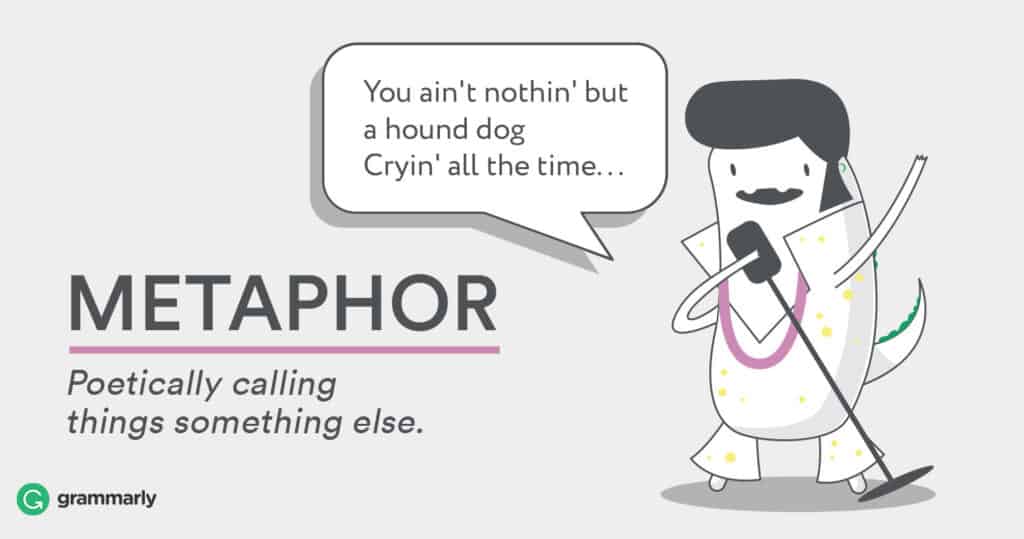
Definition: A metaphor makes a comparison between two unrelated things by stating one thing is the other thing. This is usually done by highlighting or suggesting a shared quality or characteristic between the two distinct elements.
Metaphor Examples:
- “Life is a rollercoaster” – This metaphor compares the ups and downs of life to the twists and turns of a rollercoaster ride.
- “Love is a battlefield” – This metaphor compares the challenges and difficulties of love to the struggles of a battlefield.
- “The world is a stage” – This metaphor compares the events of the world to a theatrical performance, where individuals play their parts and have their moment in the spotlight.
- “He’s a rockstar” – This metaphor compares a person’s popularity, success, or charisma to a famous rockstar.
- “School is a prison” – This metaphor compares the experience of going to school to being imprisoned or confined, highlighting the perceived lack of freedom and control that students may feel.
Metaphor Writing Tips for Students and Teachers:
- Originality always impresses: Students should strive to be creative and original when using metaphors. Instead of relying on cliches or overused metaphors, they should try to create unique and interesting comparisons that genuinely enhance their writing.
- Be Consistent: Once a metaphor is introduced in your writing, it should be used consistently throughout your work. This helps to reinforce the connection between the two things being compared and creates a more cohesive and impactful piece of writing.
- Avoid mixed metaphors: A mixed metaphor is when two or more metaphors are used in the same sentence or paragraph, resulting in a confusing or illogical comparison. Students should avoid mixed metaphors and ensure that their comparisons make sense and are consistent throughout their writing. An example of a mixed metaphor is “I smell a rat, but we’ll nip it in the bud.”
In this sentence, “smell a rat” is a metaphor that means to sense that something is wrong or suspicious, while “nip it in the bud” is a different metaphor that means to stop something before it becomes a bigger problem. The two metaphors, however, are contradictory – if you’ve already smelled a rat, it’s too late to nip it in the bud. This creates confusion for the reader and makes the sentence less effective.
Metaphor Teaching Task: Metaphors are commonly used in speech, poetry, plays, songs, and stories. To give your students practice identifying metaphors in a range of contexts, organize them into groups and provide them with a range of the types of reading materials listed above. Have students read and listen to these materials and identify examples of metaphor in each, compiling a list as they go.
OXYMORON:
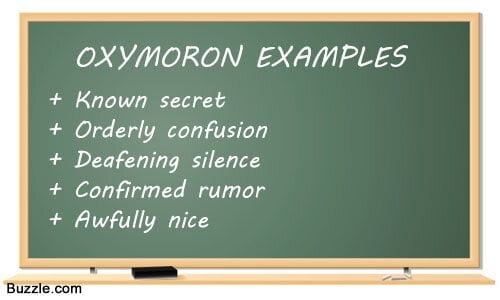
Definition: Oxymorons combine two opposing elements into a single phrase or sentence. They can be used to create a range of effects, comedic, dramatic, or thought-provoking.
Oxymoron Examples
- “Jumbo shrimp” – This oxymoron combines two opposite words to create a humorous and memorable phrase.
- “Pretty ugly” – This oxymoron combines two contradictory words to describe something unattractive or not aesthetically pleasing.
- “Silent scream” – This oxymoron combines two words that are opposite in meaning to describe a scream expressed without sound.
- “Awfully good” – This oxymoron combines two words that are contradictory in meaning to describe something that is both good and bad at the same time.
- “Virtual reality” – This oxymoron combines two words that are opposite in meaning to describe a simulated environment that feels real, but is not actually physical.
Oxymoron Writing Tips for Students and Teachers
- Use oxymorons with purpose: Oxymorons should be used with a specific purpose, whether to create a humorous effect or to add a sense of contrast or contradiction. Students should avoid using oxymorons just for the sake of using them, as this can detract from the impact of their writing.
- Don’t overdo oxymorons: While oxymorons can be effective, using too many in a piece of writing can make it seem contrived or gimmicky. Therefore, students should use oxymorons judiciously and only when they add value to their writing.
- Oxymorons must make sense: An oxymoron combines two words with opposite meanings. However, students should ensure that the combined words make sense and create a clear and compelling contrast. Using a nonsensical oxymoron can confuse readers and undermine the effectiveness of the writing.
Oxymoron Teaching Task: Oxymorons are very common in our daily speech, for example, ‘seriously funny’, ‘random order’, and ‘pretty ugly’. Organise the students into groups and challenge them to come up with as many other common examples as they can. As an extension exercise, ask the students to compose some original oxymorons too.
PERSONIFICATION:
Definition: Personification is a special metaphor where human actions or feelings are ascribed to a non-human thing. When we talk about something that isn’t human as if it was, then we are personifying it – that is, making it into a person. This figurative use of language is most commonly associated with poetry and literary fiction, but we can often find it in our daily speech too.
Personification Examples:
- “The stars danced in the sky.” – This personifies the stars by giving them human-like dancing qualities, which creates a vivid and engaging image in the reader’s mind.
- “The wind whispered secrets to the trees.” – This personifies the wind by giving it the ability to whisper secrets, which creates a sense of mystery and intrigue.
- “The sun smiled down on us.” – This personifies the sun by giving it the ability to smile, which creates a warm and positive image in the reader’s mind.
- “The car coughed and sputtered to life.” – This personifies the car by giving it the human-like quality of coughing and sputtering, which creates a sense of character and personality.
- “The waves crashed angrily against the shore.” – This personifies the waves by giving them the human-like quality of anger, which creates a sense of drama and tension in the scene.
Personification Writing Tips for Students and Teachers
- Use personification to create vivid imagery: Personification is a great tool for creating vivid, memorable images in the reader’s mind. Students should aim to use personification to describe things in a way that helps the reader visualize them more clearly and engage with the text on a deeper level.
- Be creative and original: While there are some common examples of personification (such as giving inanimate objects human-like qualities), students should aim to be creative and come up with original ways to personify things in their writing. This can make their writing stand out and be more memorable.
- Use personification intentionally: Personification should be used intentionally and purposefully to enhance the meaning of the writing. Students should consider why they are personifying something and how it adds to the overall effect of their writing. Overuse of personification can be distracting and detract from the impact of the writing.
Personification Teaching Task: Organize the students into pairs. Instruct Partner 1 to compile a list of 10 nouns, these can be inanimate objects such as a pencil, a chair etc or natural phenomenon such as moon, stars, sun etc. Have Partner 2 compile a list of 10 verbs associated with the actions of human beings, for example laugh, tell, sing etc. When both partners have completed their lists they can use their nouns and verbs to write their own personification sentences.
SIMILE:

Definition: Similes make comparisons between two seemingly unrelated elements by using ‘like’ or ‘as’ to highlight a common quality or characteristic both things share. Similes make a comparison by suggesting a similarity between two things, rather than making a comparison by stating that one thing is something else – such as we find with metaphors.
Simile Examples:
- “He runs as fast as a cheetah.” – This simile compares the speed of a person to that of a cheetah, which creates a vivid image in the reader’s mind.
- “She sings like an angel.” – This simile compares the quality of a person’s singing to that of an angel, which creates a sense of beauty and grace.
- “The water was as cold as ice.” – This simile compares the temperature of the water to that of ice, which creates a sense of discomfort and coldness.
- “The room was as dark as night.” – This simile compares the level of darkness in a room to that of nighttime, which creates a sense of foreboding or danger.
- “His heart pounded like a drum.” – This simile compares the sound of a person’s heartbeat to that of a drum, which creates a sense of urgency or excitement.
Simile Writing Tips for Students and Teachers
- Choose effective comparisons: A simile is only effective if it makes a clear comparison that enhances the reader’s understanding or emotional response to the text. Students should choose comparisons that are relevant, impactful, and easy to understand.
- Be creative: While some similes are commonly used, students should strive to be original and creative with their comparisons. Using unique or unexpected similes can make their writing more engaging and memorable.
- Use similes with purpose: Similes should be used purposefully and intentionally to add meaning or emotion to the text. Students should consider why they are using a simile and how it contributes to the overall effect of the writing. Using similes can make the writing seem contrived or formulaic, so students should use them sparingly and only when they add value to the text.
Simile Teaching Task: Begin this activity by asking students to compile a list of say 10 nouns and 10 adjectives. Challenge the students to form original similes utilising the nouns and the adjectives on their list to set up a simile comparison. For example, if they choose the noun cat and the adjective smart they must generate the final element to complete their simile, for example, The cat is as smart as a computer. They should do this until they have completed a simile for all items on their lists. Encourage them to strike a balance between the similes that use like to make the comparison and those that use as.
SYNECDOCHE:
Definition: This figure of speech most often occurs when a part of a thing is used to represent the whole of a thing. However, it can also occur when the whole of a thing is used to stand for a part of a thing. The first type is called microcosm and the second, macrocosm. This trope is better conveyed through illustration than explanation.
Synedoche Examples:
- “I need to hit the books.” – In this phrase, the word “books” represents studying or academic work as a whole.
- “All eyes were on him.” – In this phrase, the word “eyes” is used to represent the attention or focus of a group of people.
- “Check out my new wheels.” – In this phrase, the word “wheels” represents a car or other vehicle as a whole.
- “The team needs some fresh legs.” – In this phrase, the words “fresh legs” represent new or rested players who can contribute to the team’s success.
- “Can you give me a hand?” – In this phrase, the word “hand” represents physical help or general assistance.
Synedoche Writing Tips for Students and Teachers
- Use synecdoche purposefully: Synecdoche can be a powerful tool for creating memorable and impactful writing, but it should be used purposefully and with intention. Students should consider why they are using synecdoche and how it contributes to the overall meaning or effect of their writing.
- Choose practical parts to represent the whole: Synecdoche relies on a part of something to represent the whole. Students should choose relevant, recognizable, and effective parts conveying the larger concept or idea.
- Be clear and concise: Synecdoche can be confusing if not used clearly and concisely. Students should be careful to explain the larger concept or idea that is being represented by the part, and avoid using too many synecdochical phrases in a single piece of writing.
Synedoche Teaching Task: Organize students into groups and give out copies of old newspapers. Challenge the students to spot examples of synecdoche in the various articles and then highlight them. They may wish to use two separate colors for identifying the two different types mentioned above.
II. SCHEMES
Schemes are a figurative use of language that deviates from the usual mechanics of a sentence. This may be in terms of syntax, sound, or word order. Writers can use schemes to create rhythm, musicality, or to draw comparisons or contrasts within a text. They are particularly associated with poetry, as they often work on a rhythmic basis or through sound. Unlike tropes, schemes operate on a sense level more than an intellectual level.
ALLITERATION:
Definition: The repetition of the initial consonant sound of consecutive or near consecutive words for effect. Alliteration is also referred to as head rhyme or initial rhyme.
Alliteration Examples:
- “Peter Piper picked a peck of pickled peppers.”
- “Sally sells seashells by the seashore.”
- “Billy the brave battled the big bad bear.”
- “The furious fireman fought the fiery flames.”
- “Dancing dolphins dive and dart through the deep blue sea.”
Task: Read some tongue twisters as a class and then challenge the students to produce their own examples.
ASSONANCE:

Definition: The repetition of vowel sounds within a group of words. As with alliteration, the repeating sounds are important, not the letters.
Assonance Examples:
- “The rain in Spain falls mainly on the plain.”
- “The cat sat on the mat and licked its paws.”
- “The bright light might blind my sight.”
- “I like to ride my bike by the side of the lake.”
- “I feel the beat and move my feet to the rhythm of the music.”
- Fleet feet sweep by sleeping geese” by Pink Floyd
Task: Assonance can be used to convey different moods. For example, repetition of long, broad ‘o’ and ‘a’ sounds can express sadness or melancholy. Challenge your students to write a line that uses assonance to express a selected mood.
CONSONANCE:
Definition: The repetition of consonant sounds anywhere in words near each other. This should be distinguished from alliteration, where the repetition is limited to the sounds at the beginning of words. Alliteration is a particular type of consonance, so all alliteration is a form of consonance, but not all consonance is alliteration.
Consonance Examples:
- “Mike likes his new bike.”
- “The pitter-patter of little feet.”
- “The big, bad wolf blew down the house.”
- “Silly Sally sold seashells by the seashore.”
- “The ship has sailed away to a distant bay.”
- “I’m sure she sells sea-shore shells”
Task: Give out a worksheet with a mix of unmarked examples of alliteration, consonance, and assonance and have the students sort them into the correct categories. You may want the students to use a Venn diagram so they can more easily categorize those that fit into more than one category.
ONOMATOPOEIA:
Definition: Onomatopoeia refers to words that sound like the thing they describe. Onomatopoeia is most commonly seen in poetry, where its use is a powerful tool for the imagination as it imitates the sounds of the things described. A typical example of onomatopoeia can be seen in the names of the sounds various animals make.
Onomatopoeia Examples:
- “Sizzle” – the sound of something frying or grilling.
- “Crash” – the sound of something breaking or smashing.
- “Buzz” – the sound of a bee or an electrical device.
- “Whoosh” – the sound of something rushing past quickly.
- “Thud” – the sound of something heavy falling or hitting a surface.
- “Pop” – the sound of something bursting or exploding.
- “Splat” – the sound of something hitting a surface and spreading out.
- “Chirp” – the sound of a bird or a cricket.
- “Boom” – the sound of an explosion or loud impact.
- “Slurp” – the sound of someone or something drinking or eating noisily.
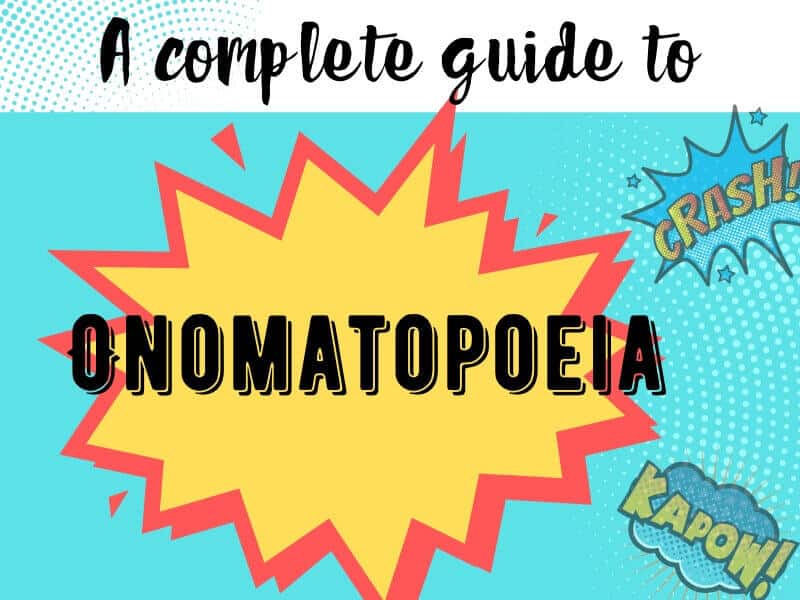
Task: To get your students thinking about onomatopoeia, give them a theme and challenge them to list as many onomatopoeic words as they can around that theme. This can easily be differentiated for various age groups. For example, younger kids can work on animal sounds like those above, while older students can work on a theme like water (drip, splish, splosh, splash, plop etc). For stronger students, provide them with a theme and task them with creating their own related and original onomatopoeic words.
PARALLELISM:
Definition: This scheme is also known as a parallel structure and applies to sentences or phrases that employ an identical or very similar structure. Parallelism is often used to bring clarity and emphasis and create a memorable rhythm. Some of history’s most memorable speeches and statements used parallelism to great effect and have stayed with us for many decades. Neil Armstrong’s reported words on the moon landing and Martin Luther King’s I Have a Dream speech being prime examples.

Parallelism Examples:
- “I came, I saw, I conquered.”
- “She likes to dance, to sing, and to act.”
- “He spent the day fishing, hiking, and exploring.”
- “The movie was action-packed, suspenseful, and thrilling.”
- “She is talented, funny, and kind-hearted.”
- That’s one small step for a man. One giant leap for mankind.” by Neil Armstrong.
Task: Provide students with sample sentences that do not use a parallel structure within them. Challenge the students to rewrite the sentences to incorporate a parallel structure into the new sentences. For example, give the students the following sentence:
Do you prefer spicy chicken, pork, or salty fish for the main course?
Students should work to recognize that the underlying structure involves an adjective preceding two of the food options and should rewrite the sentence to include one for the pork. Answers will, of course, vary, but all are valid as long as they conform to the pattern. For example:
Do you prefer spicy chicken, sweet pork, or salty fish for the main course?
Go Figure!
These are just some of the various ways language is commonly used figuratively. There are many more, though some of these can be rarely used. It’s best to start with these more common ones before moving on to some more complex literary devices available.
Spending some time working on figurative language in isolation will help students to understand how to use the various figures of speech in their own writing.
But, using them in a confident and unselfconscious manner will require lots of reinforcement throughout the school year.
While early attempts to weave them into their own writing may seem stilted and unnatural, with time and practice, they will become part of a student’s personal style and help enable them to articulate and express their thoughts artistically and coherently.








